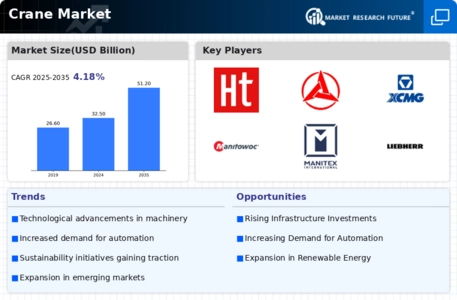Market Share
Crane Market Share Analysis
Cranes are crucial in the construction industry because they have the strength and capability to move heavy materials in different directions—upward, downward, and horizontally. Various types of cranes, such as truck cranes, tower cranes, crawler cranes, harbor cranes, and all-terrain cranes, are available, each designed for specific purposes. Different construction projects, like building bridges, roads, houses, towers, or other structures, require specific types of cranes.
Governments worldwide are actively promoting and developing their infrastructure. In particular, developing nations are implementing various reforms and regulations to enhance their infrastructure and real estate sectors. These initiatives are expected to contribute to the growth of the construction industry globally and subsequently boost the global crane market.
Authorities in regions like North America and Europe have noticed increased spending on private construction activities, particularly in the United States and the United Kingdom. According to the US Census Bureau, the total construction expenditure in the US saw a 4% increase in 2017 compared to the previous year. The value of the construction industry in the US was USD 1,246,000 million in 2017, experiencing growth to reach USD 1,293,982 million in 2018. The table below illustrates the annual value of construction in the US from 2012 to 2018.
Year Construction Industry Value (in million USD) 2012 864,773 2013 899,186 2014 961,404 2015 1,105,718 2016 1,162,801 2017 1,246,321 2018 1,293,982 This data underscores the continuous growth and significant investment in the construction sector, indicating a positive trend that is likely to drive the demand for cranes.
Moreover, the expansion of infrastructure is not limited to the United States. Various countries are undertaking ambitious projects to enhance their transportation, energy, and communication networks. These efforts create a demand for cranes to support the construction of roads, bridges, airports, and other essential facilities.
The construction industry's growth is not solely driven by governmental initiatives; private investments and commercial projects also contribute significantly. As economies continue to develop, there is an increasing need for modern structures and facilities, further propelling the demand for cranes in the construction sector.
The ongoing trend of urbanization, coupled with the need for sustainable and modern infrastructure, is anticipated to sustain the growth of the construction industry, thereby influencing the global crane market positively.

















Leave a Comment